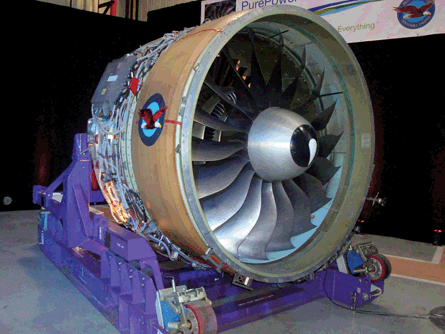The year 2010 will see airlines become increasingly frustrated at the lack of urgency being shown by Airbus and Boeing in developing clean-sheet replacements for their A320 and 737 mainline narrowbody families, which could potentially feature "game-changing" engine architectures such as open rotor.
Engine manufacturers will continue to publicise their far-reaching "green" research and technology programmes, but are unlikely to receive any firmer guidance from the big two airframers as to when they are likely to press the launch button on their new aircraft. Most of the talk in this sector of the civil market will be focused on the potential application of less radical but more immediately available technology such as Pratt & Whitney's PW1000G geared-turbofan to the existing 150-seat designs.
EFFICIENCY GAINS
The spotlight will be on the PW1000G's ability to deliver promised efficiency gains during 2010, following the engine's selection for Bombardier's CSeries, the Mitsubishi MRJ regional jet and more recently the Irkut MS-21. Meanwhile, the late-breaking news of 2009 was the selection of CFM International's Leap-X engine for China's Comac C919, which is likely to require the General Electric/Snecma joint venture to accelerate development plans during 2010 to meet the airliner's 2016 entry-into-service target date.
CFM partners GE and Snecma continue to test the CFM56-7BE engine for the next generation of the 737, expected to enter service in June 2011. CFM Boeing programmes director Kris Shepherd says the company expects to certificate the new engine in July and begin shipping units to Boeing in May.
 |
|---|
© P&W |
The -7BE will feature a 4% savings in maintenance costs due to having fewer parts and will increase specific fuel consumption by 1% over existing -7B engines, making for an overall 2% decrease in fuel consumption when combined with 737 airframe improvements. CFM is also investigating a CFM56-5B variant for Airbus A320 family.
Europe's principal engine companies Rolls-Royce, Snecma and MTU will push for progress with the European Union's flagship multi-billion euro research project Clean Sky, which promises many potential technology breakthroughs but which has struggled to overcome suffocating EU bureaucratic red tape.
At the larger end of the airliner market, R-R's Trent 1000 will have the chance to shine after the long-awaited first flight of the 787 at the tail end of 2009, while General Electric's GEnx faces two important milestones in the shape of flight debuts on both the 787 and the 747-8.
In the military market, 2010 is shaping up as a make-or-break year for exports of the Dassault Rafale, with hopes still running high that the United Arab Emirates will sign a long-awaited contract and clear the way for development of a more powerful version of the fighter's Snecma M88 powerplant. Eurojet's EJ200 - which powers the Eurofighter Typhoon - is meanwhile in the hunt for a second airframe application, with a selection due between the European powerplant and GE's F414 to equip India's indigenously developed Tejas fighter.
Source: Flight International























